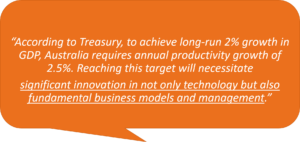Find out how any business can start building an innovation culture – and its not even all about the technology!
Got innovation slated as one of your strategic initiatives? Make sure you’ve got the culture to support your push! Let’s take a walk through the early days of a typical innovation journey for any established business.
Someone on your team – usually someone who’s engaged with industry trends or has an interest in technology or business processes – finds out or tries out a new tool, idea, process or technology.
They come back all excited to their management team, who respond by putting it “on the agenda” for their next meeting.
Said team member returns to their day-to-day work – waiting and watching to be asked for more info or to hear something, anything, back!
Only to have their enthusiasm dashed by the inevitable – “No”, “Not right now”, “Let’s park this until FY20XX” response from management.
Sound familiar?
But let me ask you this – what’s the likelihood that this person is going to keep bringing good ideas into the business? Getting their idea on the table for discussion is great, but without a process, follow-up or feedback, what incentive do they have to keep the good ideas coming?
Here are some small changes you can introduce into your business to radically change the way you and your team spark, live and promote innovation.
Step 1. Understand the culture connection!
What we know from 20 years of assisting businesses on their technology journeys is that skipping directly from idea to implementation is a sure-fire recipe for project failure without a strategy in place to guide your technology project.
 But equal to, if not more important than, the strategy piece, is the role of your organisational culture plays in the success of technology, transformation, or change projects in your business. Skipping directly from implementation to pushing full-scale adoption from any project without grass-roots support, team buy-in, feedback and reporting mechanisms and ongoing, open communication is the best way to tank any innovation initiative.
But equal to, if not more important than, the strategy piece, is the role of your organisational culture plays in the success of technology, transformation, or change projects in your business. Skipping directly from implementation to pushing full-scale adoption from any project without grass-roots support, team buy-in, feedback and reporting mechanisms and ongoing, open communication is the best way to tank any innovation initiative.
Legendary management consultant and writer Peter Drucker was spot on when he told us “Culture eats strategy for breakfast.”
Step 2. Taking the “No” out of “Innovation”
If you’re serious about getting some innovation runs on the board, you’re going to need to work out how to take the “no” out of your innovation culture.
Now don’t get us wrong. We’re not saying run wild and say yes to everything – what we’re talking about is opening up the conversation about innovation regularly , instead of just routinely shutting it down or shelving it. And this conversation needs to start and be promoted from the top-down to inspire contribution and engagement across all levels of your organisation.
Some key questions your management team will need to open up across your business to start this journey are:
- What does innovation actually mean in our business/industry?
- Are we truly interested in innovation?
- Are we confusing innovation with improving operational efficiency?
- If we think we’re innovative, do our customers actually see us that way?
- What are the constraints to promoting new ideas in our organisation?
Here’s a great article we read recently with some great tips on how you could start this process in your business.
Step 3. Creating Physical & Digital Space for innovation
Ok – now your team has started making room for talk of innovation, they’re going to need both the physical and digital space to turn ideas into reality!
What does this look like? Well here are a few ideas!
Ideas hubs: Open, closed or even anonymous forums for new ideas! Leverage some of the great tools you may have already in your organisation like Microsoft Forms to gather ideas or feedback, start circulating a media review/chat channel across your team to promote some awareness around what others in your industry are doing, heck even set up an old-fashioned ideas box if that’s going to work for your team!
Processes & parameters: Collecting ideas is great – but what happens next? Make sure you’ve got clearly defined and communicated processes and parameters around how new ideas are vetoed or promoted to the next level of discussion, if, how and when ideas will be shared with the team, and how following through on new ideas will be resourced.
Digital collaboration tools: Here comes the tech! You’ll have heard us say it a lot this year – collaboration is the new cloud in terms of what’s hot in business technology at the moment. Digital collaboration tools are paving the way for easier and faster discussion and decision-making processes, and so might be the perfect fit in your newly minted innovation culture. Our favourite collaboration tool is Microsoft Teams. Start checking out what embracing a collaboration platform might add to your culture of innovation.
Industry engagement: Time and energy for people in your team (and not only your senior management team) to attend and participate in industry events, workshops, training, mentoring and peer-to-peer engagement. If they’ve got an idea that’s a winner for your business, make time and space for them to build the skills they need to bring back into your business to make it work.
Execution, training & story-telling time: By this we mean regular, scheduled sessions where people involved in innovation projects can freed up to progress their projects, share their work with the broader team, provide training on new tools and processes coming into the business if appropriate, and keeping your innovation flow going with success stories and “look how far we’ve come” presentations.
Step 4: Finding and fostering your change champions
 Building a culture of innovation will involve engaging people across all levels of the organisation who are passionate about change – not just the “visionaries” in your business or the senior management team. Take a look across your team, and maybe even use some personality profiling tools, to assess who the early advocates, promoters, adopters, supporters, change communicators and story-tellers might be in your business. Then set about finding inclusive ways to identify, support and reward these people to expand their sphere of influence in your business.
Building a culture of innovation will involve engaging people across all levels of the organisation who are passionate about change – not just the “visionaries” in your business or the senior management team. Take a look across your team, and maybe even use some personality profiling tools, to assess who the early advocates, promoters, adopters, supporters, change communicators and story-tellers might be in your business. Then set about finding inclusive ways to identify, support and reward these people to expand their sphere of influence in your business.
Here’s a top tip – your change champions do not have to be technical, experienced, credentialed or c-suiters; they could be the most senior or the most junior in your team! Stay open minded!
What’s the end game?
We get it – sometimes all the hype around innovation and disruption gets overwhelming. Running a business now is busy enough without setting aside time and energy to work on what’s next. To give you one insight into what innovation means for Australian businesses, we’ll leave you with this comment from some of the latest economic modelling by PwC.

Increased productivity and growth in Australia will need to come from changing the models and management processes that exist in our business today, and this will not just be about technology.
Start setting yourself up for success by taking the “no” out of innovation in your business and building real opportunities for innovation success.
Talk to Maxsum today about starting an innovation journey and about new horizons in collaboration, data and IoT. Call 1300 629 786 or Contact Us Here.


